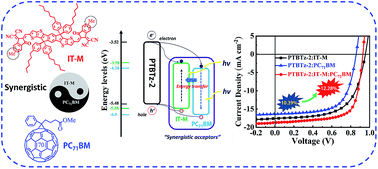The comprehensive utilization of the synergistic effect of fullerene and non-fullerene acceptors to achieve highly efficient polymer solar cells†
Abstract
A ternary strategy could combine the advantages of incorporated materials as an encouraging approach to achieve high power conversion efficiency (PCE) polymer solar cells (PSCs). In this work, ternary PSCs based on PTBTz-2:IT-M:PC71BM with different weight ratios were systematically investigated. With 20 wt% PC71BM incorporated into the accepters, the PSCs achieved the best PCE as high as 12.28% with an open-circuit voltage (VOC) of 0.928 V, a short-circuit current density (JSC) of 18.70 mA cm−2 and a fill factor (FF) of 70.78%, which is undoubtedly superior to those of binary devices based on PTBTz-2:IT-M (10.39%) or PTBTz-2:PC71BM (9.20%). The energy transfer mechanism between PC71BM and IT-M was investigated in depth by femtosecond pump–probe transient absorption spectroscopy and time-correlated single-photon counting. The Förster resonance energy transfer mechanism between PC71BM and IT-M has been powerfully verified. Morphology characterization analysis, density of states theory and density functional theory calculations indicated that the excellent combination of PC71BM and IT-M has a synergistic effect on the VOC values of the devices. Our results suggested that the two acceptors with drastically different structures could synergistically combine the merits of each to optimize crystallinity and charge generation, separation, and collection, which simultaneously enhanced the PCEs.

- This article is part of the themed collection: 2019 Journal of Materials Chemistry A Most Popular Articles


 Please wait while we load your content...
Please wait while we load your content...